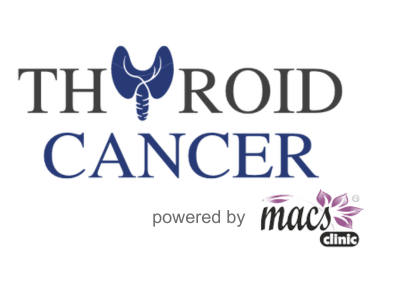Papillary thyroid cancer (PTC) is the most common form of thyroid cancer. In many instances, it grows slowly enough that it may not pose a threat to health. For patients diagnosed with low-risk papillary thyroid cancer, a less aggressive approach known as active surveillance (AS) is becoming increasingly popular. Recent research indicates that for some patients, closely monitoring the tumor instead of immediately opting for thyroid cancer surgery can be just as safe and may help avoid unnecessary complications.
“Low-risk papillary thyroid cancer usually develops slowly and rarely poses a significant threat to a patient’s health. With the right expertise and approach, we can help patients feel confident about their condition while avoiding overtreatments.”
Dr. Sandeep Nayak is the Chairman – Oncology Services, Karnataka, India, and Executive Director – Surgical Oncology and Robotic Surgery, KIMS Hospital, Bangalore. He is globally recognized for his expertise in managing thyroid cancer and his contributions to cancer care, including minimally invasive techniques like scarless robotic thyroid surgery.
What Is Low-Risk Papillary Thyroid Cancer?
A tumor is considered low-risk if it:
- Is small: Usually 1 cm or smaller in diameter.
- Has not spread: There’s no sign of cancer in nearby lymph nodes or other body parts.
- Has not invaded nearby tissues: The cancer is confined to the thyroid and hasn’t started growing into surrounding areas (this is called extrathyroidal extension, or ETE).
If you meet these criteria, your doctor might recommend active surveillance instead of immediate surgery.

Have questions about your diagnosis? Reach out to a seasoned oncologist to understand if your condition qualifies as low-risk.
What Is Active Surveillance?
How Does Active Surveillance Work?
1. Regular Ultrasounds
- In the first year, ultrasounds of the thyroid are done every 6 months to ensure the tumor remains stable.
- After the first year, if the cancer is not growing, the frequency of ultrasounds may decrease to once a year or even longer intervals, depending on your doctor’s recommendation.

2. Physical Examinations
- Routine physical exams of the neck are done during follow-up visits to check for any signs of changes in the thyroid or nearby lymph nodes.

- Your doctor will look for any changes in the size of the tumor (e.g., growth of 3 mm or more) or the development of new features, like spread to nearby lymph nodes or signs of extrathyroidal extension.
Not sure if active surveillance is right for you? Seek expert guidance to explore your options for managing thyroid cancer.
What Happens If the Cancer Grows?
While most patients on AS will not experience tumor growth, about 7% of patients may see their cancer change over time. If the tumor grows larger, begins to spread, or develops features that could make it more aggressive, your doctor may recommend surgery to remove cancer.
This delayed surgery, known as conversion surgery (CS), has been shown to be just as effective as surgery performed immediately after diagnosis. The study at Memorial Sloan Kettering Cancer Center found that patients who underwent CS after AS had survival rates and outcomes that were just as good as those who had surgery right away.

Why Choose Active Surveillance?
A recent study confirms that active surveillance is a safe option for people with low-risk PTC. If you’re a candidate for AS, here are some important takeaways:
- You have time. Low-risk PTC grows so slowly that immediate surgery is often unnecessary. You can safely monitor it with your doctor and decide on surgery later if needed.
- Surgery is still an option if needed. If the cancer starts to grow or change, surgery can still be performed with excellent results.
- Fewer complications. By avoiding surgery upfront, AS can reduce the risks of complications like vocal cord damage or low calcium levels, which can occur after thyroid surgery.
What Does the Research Say?

Here are some key findings from the study that compared patients who chose active surveillance (AS) with those who had immediate surgery (IS):
1. Most Patients Stayed on Active Surveillance
Only 7.1% of patients (about 1 in 14) eventually needed surgery because their cancer grew. This means that for the majority of patients, monitoring the tumor was safe, and surgery wasn’t necessary.
2. Outcomes Were Excellent for Both Groups
- Survival rates were 100% in both groups.
- Recurrence rates were low. After five years, 86% of the conversion surgery group and 100% of the immediate surgery group had no signs of the cancer coming back.
3. Surgery After AS Was No More Complicated
One concern about waiting for surgery is whether it might become more difficult as the cancer grows. The study found this wasn’t the case. Patients who had conversion surgery after AS had similar rates of surgical complications compared to those who had immediate surgery.
4. Ultrasounds Can Be Misleading
Sometimes, doctors recommend surgery because imaging tests like ultrasounds suggest the cancer is spreading. However, the study found that these tests can sometimes overestimate the risk. For instance, many patients who were suspected of having extrathyroidal extension (ETE) didn’t have it when their tissue was examined after surgery.
“These findings reinforce the safety and effectiveness of active surveillance for the right patients. It’s about balancing caution with care,”
notes Dr. Sandeep Nayak.
Is Active Surveillance Right for You?

Still deciding if active surveillance fits your needs? Get in touch with a thyroid cancer specialist for personalized advice.
Final Thoughts
If you’ve been diagnosed with low-risk PTC, talk to your doctor about whether active surveillance might be right for you. By tailoring treatment to the individual, this approach offers many patients the chance to avoid unnecessary surgery without compromising their health or safety.
Written by Dr.Athira, Sheis a leading expert in the field of cancer care and is committed to providing personalized and evidence-based treatment options to his patients.
FAQs
What does "active surveillance" mean for thyroid cancer?
What symptoms should I watch for during active surveillance?
Is surgery still an option after active surveillance?
Can thyroid cancer return after treatment?
Can low-risk thyroid cancer progress to high-risk?
Disclaimer: This page is for informational purposes and not for promotional use.

